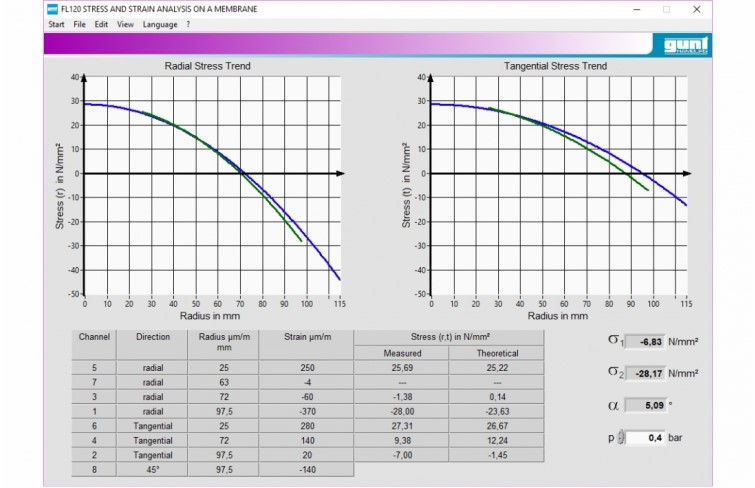SM-301 | Circular Diaphragm Disk

- Investigate the deflection and strain of a thin disk under compressive load
- Strain gauges measure in the radial and tangential direction
- Strain gauge configured as half-bridge
- Possible to measure the deflection at any radius
- Measure the deflection via adjustable dial gauge, scale indicates position along the radius
- Hermetically sealed hydraulic system, maintenance-free, for generating the compressive load
- Hydraulic system with hydraulic pump and manometer
- Measuring amplifier required
- LxWxH: 700x350x350mm
- Weight: approx. 25kg
Description
Technical Specification
Media
In experimental stress and strain analysis, strain gauges are used to determine stresses and strains in components and structures. The maximum stresses and strains are key variables in terms of its structure, and ultimately dictate the dimensions of a component. Strain gauges provide the means required to evaluate mechanical stress and strains.
The experimental unit can be used to measure the deflection and strain of a disk under different compressive loads. For this purpose, a thin disk, also called a membrane or diaphragm, is clamped into place and subjected to pressure. A cylinder with a hand-operated piston generates pressure in a maintenance-free hydraulic system. This pressure is indicated on a manometer. Strains on the surface of the membrane are recorded by strain gauges. The layout of the strain gauges at optimally selected points provides a comprehensive view of the stresses and strains over the entire disk. The maximum stresses and strains are calculated by applying the law of elasticity.
The strain gauge measurements are recorded and displayed by means of the measuring amplifier. The measured values can be imported into the application software for visualization to evaluate the experiment.
At the same time, the deflection of the membrane is measured by a dial gauge. The dial gauge can be moved along a cross-member, enabling measurements to be taken at any radius.


Aluminum disk
- outer diameter: Ø 230mm
- diameter used in the experiment: Ø 200mm
- thickness: 3mm
Strain gauge application
- 8 strain gauges: half-bridges, 350 Ohm
- gauge factor: 2,00 ±1%
- power supply: 10V
Dial gauge
- 0…20mm
- graduation: 0,01mm
Manometer
- 0…1bar
- accuracy: class 1,0
System pressure
- 0,6bar
Any questions? We are happy to help...
+49 40 670 854 - 0
sales@gunt.de
Newsletter
About Us
EduTech Lahore excels in designing and supplying cutting-edge equipment for Engineering Education in Mechanical, Polymer Chemical, Civil and Control Engineering. Focused on meeting the demand for quality education, we offer cost-effective solutions for the latest teaching equipment.
Contact Info
Head Office (Asia)
EduTech
Lahore
Regional Partner Office (UK)
Sales Partner (Middle East) GCC International FZC
Leave a Message
WhatsApp us
